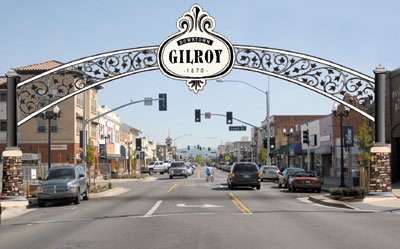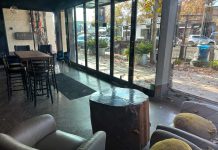Gilroy
– Like so many of America’s quaintest downtowns, Gilroy has the
chance to welcome visitors to its historic heart with a grand arch
spanning its main street.
Gilroy – Like so many of America’s quaintest downtowns, Gilroy has the chance to welcome visitors to its historic heart with a grand arch spanning its main street. But the project may get scuttled because of regulatory hassles and a tug-of-war over the best way to capitalize on a local developer’s offer.
Last year, developer James Suner and his partners Richard Klevins and Gus Khamneipur pledged to spend $200,000 on a downtown welcoming arch. The proposal accompanied their efforts to get regulatory approval for a development just south of the city’s historic business district, and represented one of many wish-list items elaborated in development guidelines for the area.
“The whole idea is place-making,” said Suner, who served for two years on the task force that developed the Downtown Specific Plan. “It identifies the downtown as a place, and if you can build (a) second arch it defines the historic core, so you have an entry into that place from both directions. I think the arch is a good idea.”
Suner’s not the only one who thinks the idea is worthwhile.
“You see it in a lot of places that have a nice downtown,” Councilman Dion Bracco said. “They have a gateway arch inviting you into the downtown.”
Yet Bracco and other councilmen did not require the spending as a condition of approval for Suner’s 11th Street Commons project. In fact, the city has spurned the funding for “lack of a mechanism” to accept such contributions, according to City Planner Gregg Polubinsky.
Suner is not the first developer to try to sweeten a proposal by offering so-called “public amenities” or “value-added items.” In recent weeks, developer Chris Cote pledged $500,000 for an alternative energy and technology fund in exchange for approval of 18 solar-powered homes on Gurries Drive. City officials did not factor in the pledge when voting on approval, since Cote was unwilling to give the city control – or oversight – of the funds. But officials were in bounds asking for such control since the developer was asking them to grant flexibility on zoning regulations, Polubinsky said. But Suner’s project met all the requirements of existing zoning rules, Polubinsky said, meaning the city couldn’t accept the donation – at least not as a condition of approval.
“The other thing about the arch is that a lot effort has to go into where you put it, how it should look structurally and aesthetically,” Polubinsky said. “That’s kind of a major design project.”
Suner is no more anxious to tackle the project than the city, since it could require permitting to dig up public sidewalks and streets – an undertaking that would rival the months-long process typically involved in getting permits for a new building. He originally proposed the arch for installation on Monterey Street at the intersection of either Third or Eighth streets, but he acknowledged the need for months of public meetings to plan the look and location of the arch.
Instead, Suner is now proposing to donate the money to the Downtown Business Association and earmark it for signage or a paseo – a walkway that passes through buildings. The latter may trump the welcoming arch on the list of priorities, since officials have cited paseos as a crucial ingredient in avoiding a downtown parking crunch. A newly remodeled Monterey Street opened to the public in October following a seven-month construction project, and employees quickly monopolized storefront spaces. Officials hope to free up those spaces by providing direct connections to parking behind businesses along Monterey Street.
“An arch maybe isn’t the most needed thing right now,” Mayor Al Pinheiro said. “The paseos are obviously things we certainly need in our downtown – a couple of them. The city’s working to identify a place for them … I’d love to see (arches) down the road, but when you start prioritizing, paseos are needed to help with the parking issues.”
Downtown businessman Michael Brownfield, who owns a vacuum store between Sixth and Fifth streets, said the city should focus first on installing two pairs of banner poles near Sixth and Fourth streets.
The city installed cement moorings for the poles during last year’s Streetscape project, but does not have the funds for the poles that would be used to drape special-event banners.
“I think we need a beginning and ending of the downtown,” Brownfield said, referring to the welcoming arches. “But I would like to see us finish these (banner poles) first.”
Suner’s $200,000 gift would be more than enough to cover the cost of the banner poles, said City Transportation Engineer Don Dey, though he could not give a precise cost for the project. The $200,000 also could help install art, informational kiosks bearing the names of local businesses, a downtown public square, or any number of other items.
For the moment, it remains unclear how the money will be spent. Long-time resident Dave Galtman Sr. could not decide which priority tops the list, but he said it’s a problem worth having.
“There’s a lot of need for things downtown that the city won’t have the money to take care of right away, so that $200,000 would be a great benefit,” he said. “The money’s there. Let’s use it.”















